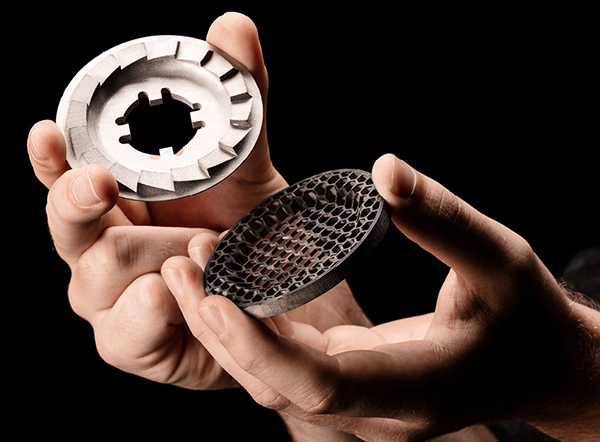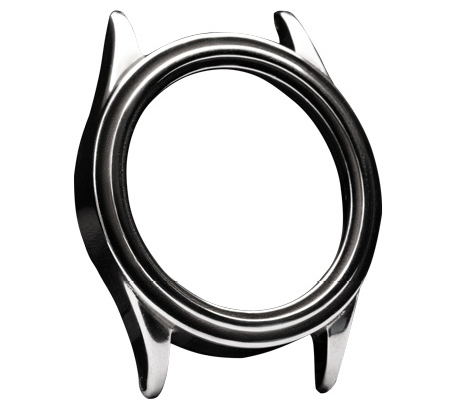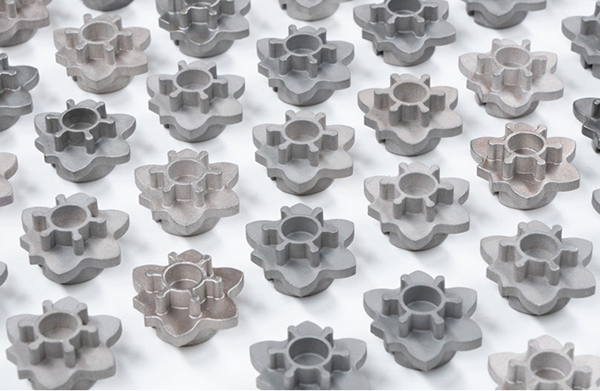Additive Manufacturing 2.0: Building a Resilient, Diverse, Secure Supply Chain
A new executive order and cybersecurity concerns shine light on the state of 3D printing.

This clutch plate was fabricated using 3D printing and additive manufacturing techniques. It exemplifies the detail and complexity or direct parts that may be fabricated in lieu of relying exclusively on a supplier to fabricate the same. Image courtesy of Desktop Metal.
Latest News
May 17, 2021
In February 2021, President Biden issued an executive order to specifically address United States supply chains, stating:
“More resilient supply chains are secure and diverse—facilitating greater domestic production, a range of supply, built-in redundancies, adequate stockpiles, safe and secure digital networks and a world-class American manufacturing base and workforce.”
This is in response to manufacturing supply chain snags due to the pandemic. Suppliers and their workers, in many cases, had been unable to supply according to demand signals due to multiple factors.
Such factors included everything from the safe presence of workers in the workspace, to the unavailability of supplies, and a sluggish—if not halted—transportation pipeline that would allow parts, commodities and materials to be transported.
Self-Sufficiency in a “Make it Yourself” Supply Chain
3D printing and additive manufacturing (AM) aren’t what they once were—they’re getting better every year. 3D printers are fast, quite accurate and can accommodate feedstocks with materials and different composites that possess unique properties for finished products that you might not think possible to be fabricated from a 3D printer. With a high-quality 3D printer and reliable materials, you can make parts yourself.
“All companies are going to change the way that they view how they manufacture products and what their internal corporate plans are around this,” says Jonah Myerberg, CTO and co-founder of Desktop Metal. “I think we saw a lot of that with this pandemic.
“When companies, even hospitals, were kind of strapped, they were putting a very tough position on how they would get spare parts or converters, or how they would remain flexible when they had certain pieces of equipment and other pieces of equipment that didn’t fit the pieces of equipment. And they were able to very quickly create parts that they needed either themselves or with local 3D printing suppliers,” he says.
The self-sufficiency that fabrication via 3D printing affords doesn’t just come in handy during the pandemic. It’s also on the brink of becoming a major strategic advantage in helping manufacturers be more competitive.
“Advanced technology such as 3D printing, robotics, advanced machine tools, artificial intelligence, IoT and new software and sensors are all key technologies to expanding manufacturing in the U.S. Through leveraging technology, companies can extract labor costs and improve efficiency and productivity,” says Rosemary Coates, founder and executive director of the Reshoring Institute.

“In this way, factories in the U.S. are again competitive with low-cost countries,” Coates says. “Most executives will consider cost as a first step in making manufacturing and sourcing location decisions, but the pandemic has introduced risk in global supply chains. Now executive decisions are based on cost and risk. Executives are thinking more strategically about multiple manufacturing and sourcing locations.”
Douglas Krone is the CEO of Dynamism Inc., a company that focuses on 3D printing advisory, hardware, software and training. Krone says that building 3D printing capacity will benefit manufacturers in many ways. Not only can building up printing capacity alleviate some of the dependence on a downstream supply chain, but it also can help reduce cost of goods.
“By identifying components within the supply chain that can be produced in-house using 3D printing, companies cut lead times, overstock and the reliance on third-party outsourcing for hard-to-find or obsolete components,” says Krone. “When the specific components cannot be moved to 3D printing, sometimes the tooling used for manufacturing those components can be. That also saves on speed and expense of ‘tooling costs’ for manufacturing. So, there are two separate points of significant added value that come from 3D printing.”
Brent Stucker is a distinguished engineer in additive manufacturing at Ansys. He points out the added advantage of using simulation and modeling in tandem with AM to arrive at solutions using iterative processes. AM, given its fast and flexible features, make it an ideal complement to simulating designs to arrive at a better part solution. This was not readily available in the past.
“The ability to produce components directly from digital data is a huge benefit to companies becoming more self-sufficient,” says Stucker. “This is especially true if simulation is used to validate the digital design, material choices and manufacturing plan prior to production.
“The value of a holistic digital supply chain is that it enables low-quantity manufacturing, rapid product changes and the ability to shift production between any location that has capacity to produce just by sending digital information,” he adds. “As a result, digital supply chains are more resilient to disruptions than non-digital supply chains.”
Digital Information and Intellectual Property
A unique attribute of 3D printing is the capability to digitally scan an object and reverse engineer it, digitally, with relative ease. This poses a problem that hasn’t shifted to the forefront in a discussion regarding the benefit of 3D printing: Do 3D printing capabilities, now more prevalent than ever, make a designed and finished good more vulnerable to copying? Can the intellectual property of a design be more easily hijacked with the ease and flexibility of AM?
Companies have used reverse engineering for a long time. Fabricated parts, objects and forms were always vulnerable to being copied and produced, even though the digital details and plans for such a form may be proprietary. The biggest change is that now, it’s easier.
“I think we’ve always had a problem with counterfeiting,” says Myerberg. “We’ve always had problems and challenges with authenticity. And if you look at counterfeit product that comes into the country, it’s super fascinating. It’s an amazing case study to look at.”
Myerberg recounts a scenario when he worked for Bose, an audio speaker and sound accessory manufacturer. “Counterfeit wave radios would come into the country and we would deconstruct the wave radio and pull the plastic parts apart,” he says.
And we would say, ‘these are plastic components that we didn’t make.’ We didn’t injection mold this. But there were details in that plastic component that only existed in the authentic components that Bose did make.”
As Myerberg explains, companies such as Bose are gathering competitive intelligence from a like-kind product that had been copied. But the products were copied without the intrinsic quality organizations instilled in their own product lines.
“There were errors,” he says. “There were defects in the part that existed in the tools that Bose owned that a company in China duplicated exactly when they scanned it. They built the part exactly to the way that they saw it. And there were knit lines and parting lines that had no functionality whatsoever, but they were just copied.”
Myerberg says this has always been a problem of counterfeiting parts.

“3D printing allows people to scan and reproduce faster,” Myerberg notes. “But I think that what we’re going to start to see are more powerful tools to protect digital data, because one thing that additive manufacturing does, is it bridges that gap between the digital world, which may be the scanned files that you create in the physical world, ... the actual product. And it makes it a whole lot easier.”
Coates says the biggest issues in intellectual property (IP) protection stem from China.
“Your Chinese factory and suppliers are going to remember how to produce your product long after you are gone and will most likely continue to do so,” Coates says. “They know who your suppliers are, they have your drawings and your molds, they have learned how to make a quality product, and they will most likely manufacture it and sell it on the world market.
“If you have not registered your trademark in China or any foreign country where you manufacture, they may even use your brand name and logo,” Coates adds. “To protect your IP, you need to plan well in advance of leaving, and seek the help of an experienced consultant or attorney.”
Ansys’ Stucker advises that IP protection requires carefully considered and broadly followed security protocols within the supply chain.
“Other digitally-driven industries such as film production, book publishing [and] espionage agencies, have learned to protect their data until the time when they want to release it,” he says. “Digitally-enabled manufacturing needs to use secure methods of storage and transfer of information to help ensure intellectual property protection. Unprotected email, chats and file-sharing services are potential security breach locations. But by appropriate use of widely available secure transfer and storage protocols, a digital supply chain can be flexible and resilient.”
Though 3D printing can be a boon to self-sufficiency and a boost to the extended supply chain, it does require cybersecurity measures to protect access and capture of digital assets. Today, there’s ample authentication and detection, but cybersecurity is always an area that remains vulnerable.
When one risk is crossed off, it seems another risk opens up. Thus, digital engineering, especially in the age of 3D printing, must be accompanied by a thought-out cybersecurity policy and plan that specifically addresses the risk of intellectual property, digital files and assets, and their vulnerability in a globally competitive manufacturing environment.
Supply Chain-Ready 3D Printing
The very prevalence of 3D printing is in the earlier stages of an industrial revolution within an existing revolution, where shortcuts, cost-cutting and useful hacks are being employed to adequately compete; yet things changed with the arrival of a global pandemic.
The pandemic has become a force to find function for different technologies. It helps bring about a better use of technology to overcome obstacles and face challenges. 3D printing is such a technology that has flexed its muscle in bringing solutions to supply chains.
“So this AM 2.0, which we call it, is the next generation of AM,” says Myerberg. “It’s bringing 3D printing into the mass production with Industry 4.0 and digital factories of the future. That requires flexible manufacturing processes, like 3D printing. So that’s just going to pull the development and expand the development.
“High-quality metal powder production is popping up all over the globe,” Myerberg adds. “And that’s allowing mass kind of distribution of AM machines around the globe as well. So you can enable this kind of file transfer that you’re describing, and you’re going to have 3D printers massively distributed everywhere. So manufacturing is evolving quickly, and it’s really a great opportunity for everybody.”
This has happened against a backdrop of a domestic manufacturing supply chain whose resiliency has been tested. 3D printing syncs well with President Biden’s overarching objective in issuing an executive order that aims to make supply chains resilient, diverse and secure.
More Ansys Coverage
Subscribe to our FREE magazine, FREE email newsletters or both!
Latest News
About the Author
Jim Romeo is a freelance writer based in Chesapeake, VA. Send e-mail about this article to [email protected].
Follow DE





